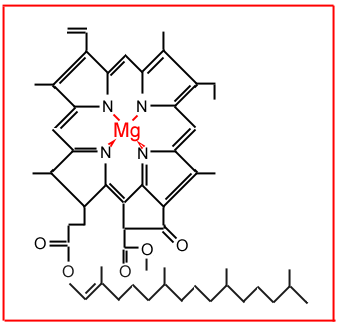|
|
|
|
|
|
|
In talking about respiration we followed energy from carbohydrates through different molecules until it was mostly in NADH and then it was converted to ATP through an electron transport chain. In photosynthesis we will follow energy from light as it is converted through another electron transport chain via ATP and NADPH back into chemical energy in carbohydrate. Many of the energy yielding reactions in respiration are irreversible; the pathways cannot simply be run backwards. In photosynthesis the electron transport pathway is an integral part of the light reactions. Light that we see and plants use for photosynthesis is a small part of the spectrum of electromagnetic radiation, from just below 400 nm to just above 700 nm. Our peak sensitivity is in the middle of this range at about 550 nm or in the green part of the spectrum. Coincidentally this is the part of the spectrum which plants do not use or"see". They absorb light in the blue and in the red. The light is absorbed by pigments, chlorophyll which absorbs red and blue light (and appears green) and carotenoids which absorb in the blue (and appear yellow). (The presence of magnesium at the center of the chlorophyll molecule accounts for much of the requirement for this element as a plant nutrient)  Chlorophyll a The pigments are concentrated in the grana that form islands, in the thylakoid membranes inside the chloroplast - where all of the reactions of photosyntheis occur. Like the mitochondrion, the chloroplast is enclosed by a double membrane, contains some of its own DNA and is thought to have originated by capture of a photosynthetic bacterium by an ancestral eukaryotic cell. In respiration we followed H+ and e- down an ATP generating pathway to combine with O and make water. The photons of light absorbed by chlorophyll cause a displacement of 2 electrons to a higher energy level which reduces a cytochrome in an electron transport chain in the thylakoid membrane. Somehow the electrons are replaced by two withdrawn from water which is split into 2 H+ and O. H+ is accumulated on the inside of the thylakoid and as it passes through a membrane ATPase it is used to drive ATP synthesis in the same way that ATP is generated in respiration. The electrons pass down a transport pathway to chlorophyll in another reaction center where they receive a boost of light energy which takes them to a high enough energy level to reduce NADP. |
|
|
There is the possibility that electrons fall back into the electron transport chain to produce more ATP but no NADPH - this is cyclic phosphorylation. However, the Z pathway or non-cyclic phosphorylation is required for carbohydrate synthesis. (the cyclic path tops up ATP) |
|
|
Plants depend for their growth and, ultimately, all life on this planet depends on this conversion of light to chemical energy Light-independent reactions The key step here is the reaction catalyzed by Rubisco (ribulose 1,5-bisphosphate carboxylase) - if there is one enzyme you should remember it is rubisco - the most abundant protein on earth and a protein on which all life depends. A 5 carbon sugar combines with CO2 to produce two 3 carbon sugar acids (PGA, which also occurs in glycolysis). To get a (3 carbon) sugar, the sugar acid, PGA must be
reduced by the NADPH produced in the light reactions. The
rest of the Calvin cycle (which we will not discuss)
involves shuffling carbon-carbon bonds to maintain the
supply of (5-C) RuBP and to give an output of (6-C) hexose.
Just as in glycolysis, all of the intermediates are
phosphorylated. The phosphate groups come from the ATP
produced in the light reactions. To see
this in action: We tend to focus on the use of light energy to produce sugars but photosynthetic cells also use this energy to reduce and convert inorganic nitrogen and sulfur into organic molecules. Just as all of the carbon compounds in our diet came originally from photosynthesis, all of the nitrogen and all of the sulfur compounds required plant energy to make them useful to us. Copyright © Michael Knee |
|